Cape of Good Hope Clipart Ming Dynasty Clip Art
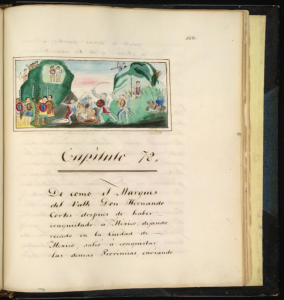
Fray Diego Durán, 1570's.
Early nineteenth-century facsimile.
Manuscript Division, Library of Congress.
Durán, Diego. "De como el Marquis del Valle Don Hernando Cortes. . . salio a conquistar las demas Provincias . . ." [Cortés and Soldiers Face up the Indians]. In La Historia antigua de la Nueva España. 19th Century. Manuscript Division, Library of Congress. Facsimile. November 2018. Library of Congress.
Horses have become an iconic feature of the Plain Indians of North America. There is an assumption that these people were always mobile through their access to horses. In reality, these long-sedentary societies were disturbed past Spain's introduction of horses. This mobile animate being gives the Plains Indians their iconic tradition of being nomadic. The introduction of horses caused dissimilar native nations to come into conflict, not merely with each other merely with the labor strength on Espana'due south territories. In reaction to the intersection of diverse races, the colonial government created a system to label backgrounds. The racial bureaucracy that the Spanish developed was an attempt to reassert their dominance after their disability to maintain their monopoly on horses that they initially enjoyed over the Indians.
A painting from Fray Diego's manuscript depicts the symbolism of the horses that the Spanish brought into colonial territories. This manuscript was made in the 1570's and was not published until the 19th century. In Fray Diego Duran's manuscript, he recorded his observations of the Indian'due south order. In i of his sections, he includes a colored delineation of the confrontation betwixt the Mexica and the powerful Spanish forces of Hernando Cortés (1485–1547) during his campaign of 1519–1521. Agreement that Fray Diego Duran was a Spanish Dominican priest, information technology follows that he would depict the Spanish as the superior people in the confrontation. The "history of the Indians" manuscript was likely tailored for the nobles and learned men in Kingdom of spain who were not able to experience first-paw the New Earth. The history could also be for the patrons that financially backed the trip. In the piece, horses are leading the Castilian in the fight confronting the Indians. For the Spanish, this symbolizes that they are justified in invading the Indian'south country. In. Spain, horses were notable elements of heroic traditions. They represented the honor and valor of the rider and thus a sign of nobility. This sign of nobility translated into New Spain, and thus the natives that began riding horses gained status. With the Spanish losing their sign of nobility, they had to turn to a racial hierarchy to reassert their say-so. The introduction of horses was the impetus for the Castilian to create the infamous racial hierarchy. Furthermore through horses we come across that once technological advancements are distributed among different people, the divide among them are minimized.
Sources:
Earle, Rebecca. The Torso of the Conqueror. New York: Cambridge Academy Printing, 2013.
Isle of man, Charles. 1493. New York: Vintage Books, 2011.
Fray Diego Durán, La Historia antigua de la Nueva España, xixthursday Century facsimile, Manuscript Segmentation, Library of Congress, November, 2018, Library of Congress.
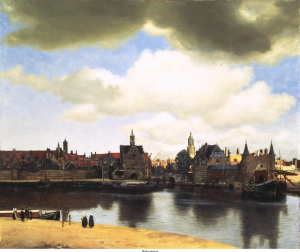
Johannes Vermeer, Delft, Netherlands, 1660-1661.
Oil on Canvas.
Dutch Royal Cabinet of Paintings at the Mauritshuis.
Vermeer, Johannes. View of Delft. 1660-1661. Oil on Canvas. Mauritshuis, The Hague. In Vermeer'due south Hat. New York: Bloomsbury Press, 2008, Plate one Insert.
The Dutch Golden Age of the 17th century, was a period where the Dutch were at the forefront of trade, scientific discipline, military, and fine art. What was the impetus for this renowned prosperity? The answer tin can exist found in Johannes Vemeer'south View of Delft. This piece was made around the height of the Gold Age, 1660, and simply depicts a view of Delft, Netherlands. In the painting, the herring busses are humbly portrayed equally an integral function of this boondocks. As integral as the herring busses are in this piece, so are they in the impetus of the Dutch Gilded Age.
Due to a global cooling, the herring industry geographically moved into the control of the Dutch. The Dutch began to exploit this newfound economy through their advancements of the herring busses. In plow, caused the prosperity of the Golden Age. 1 of the notable features of the Dutch Golden Age, is the VOC. Formed in 1602, the Dutch East Indian Company is herald as the nigh powerful trading corporation in the seventeenth-century world. As the outset modernistic stock substitution, its influence is present in modern finances. The profitable herring industry provided the financial backing that immune the Dutch to venture into creating the VOC.
The initiatives to create efficient herring busses compelled the Dutch'southward methodical and technological advancements. One of which was to create an onboard curing system on the herring busses allowing them to stay out on the water for longer period of time. In social club to compensate for the longer time at sea, a larger gunkhole and crew was necessary. The Dutch shipbuilders had to create larger boats to compensate for necessary infinite of the curing system and the larger crews needed to maintain this system. The combination of larger boats, larger crews, and technological advancements are the beginning of the military celebrity of the Dutch Golden Age.
The successful herring manufacture did non go unnoticed. Envious optics of the Dutch's enemies attempted to hamper the Dutch's profits by attacking the herring busses. In response, Dutch towns agreed to send out convoys to protect their common involvement. These convoys had to protect the busses without causing whatsoever impairment to them. This created a necessity for naval strategies among the convoys. Here, the herring busses are uniting and organizing the Dutch towns in a system to protect itself. The famous umbilicus strategies of the Dutch Gilded Age can find their roots in the navel trek to protect the herring busses.
Sources:
Brook, Timothy. 2009. Vermeer's Lid. New York: Bloomsbury Press.

1690
Silver metalwork and cowrie crush
The Metropolitan Museum of Art; 68.141.278
Spices were at the heart of World commerce in the 17th century. Information technology could exist argued that the Dutch republic congenital itself a golden age on the spice merchandise. At the elevation of their ability, the Dutch had a monopoly on the world'south supply of nutmeg and mace likewise every bit command over the vast majority of the the globe's access to cloves.
Part of the reason why the Dutch could maintain their nutmeg monopoly was because the nutmeg tree just grew on the Banda islands in Indonesia. Although efforts to cultivate the copse elsewhere mostly proved futile, to protect their monopoly the Dutch would dip their nutmeg exports in lime. To further defend their monopoly, the Dutch maintained a heavy military presence on all of the Bandan isles. These stringent measures were enacted by the governor of the Dutch East Indies of the time, a human being named Jan Pietersz Coen.
The seriousness with which Coen took the security around the Bandan isles was largely due to the fact that the Dutch were able to make a 7500% profit on each shipment of nutmegs. This was at least partly due to Coen'southward especial ruthlessness. He coerced the headmen of tribes on each island to sign contracts that established the Dutch East Indies Company every bit the sole beneficiary of their Nutmeg harvests, ratcheting down the prices for their labor to be so low equally to provoke widespread uprisings on the islands against his terms. Coen saw the uprisings as alienation of contract then declared war, eventually enslaving the native inhabitants of the islands to ensure steady production of nutmeg.
Although the Dutch had established their merits to the Banda Islands with an excessively blatant brandish of imperialism, in the eyes of the British, the westernmost Island in the archipelago, Pulo Run, was sovereign British territory. The Brits had reached the Bandas start in 1603 and had sent several subsequent, unsuccessful colonization attempts that had largely been thwarted by the Dutch.
Tensions over Pulo Run contributed to the outbreak of both Anglo-Dutch wars. Terms that required the return of Pulo Run to British ownership were expressly stated in the treaty of Whitehall of 1662 which marked the cease of the first Anglo-Dutch state of war. Although the British attempted a render to claim the island, by the fourth dimension they managed to launch an expedition, the second Anglo-Dutch state of war had begun and the Dutch in one case once more prevented English occupation of the island. They had managed to continue their monopoly.
The treaty of Breda doesn't expressly state the names of whatsoever territories. Great britain and the United Netherlands (every bit Kingdom of the netherlands was then known) instead agreed that all territories that had been captured over the course of the state of war were to be exist kept of by the captor. This was finer a game of monopoly where the Dutch exchanged their colony of New Amsterdam on Manhattan Island in the American Northeast for the British territory on Suriname and the British claim to the Island of Pulo Run.
Such was the describe of the monopoly that Nutmeg offered. For the Dutch, Even though the entirety of their Nutmeg ingather came from the the two main islands of Banda and Naira, they couldn't let the Brits the possibility of breaking their monopoly with the island of Pulo Run.
Sources:
Davenport, F.Yard., and C.O. Paullin. "Treaty of Friendship between Great Britain and the United Netherlands Ended at Whitehall September 4/14 1662." In European Treaties Begetting on the History of the United states and Its Dependencies , 73–85. Carnegie Institution of Washington Publication. Lawbook Exchange, 2004. https://books.google.com/books?id=mDPF4ILESaUC.
———. "Treaty of Peace and Alliance between the United Netherlands and Groovy Britain, Concluded at Breda, July 21/31, 1667." In European Treaties Begetting on the History of the The states and Its Dependencies , 73–85. Carnegie Institution of Washington Publication. Lawbook Substitution, 2004. https://books.google.com/books?id=mDPF4ILESaUC.
Donkin, R.A. Between Due east and West: The Moluccas and the Traffic in Spices Up to the Inflow of Europeans . Memoirs of the American Philosophical Guild. American Philosophical Society, 2003. https://books.google.com/books?id=-AdJrE5RDvYC.
Keay, J. The Spice Route: A History . John Murray, 2006. https://books.google.com/books?id=D3m3MgEACAAJ.
Michael Krondl. "The Company Human being." In The Taste of Conquest; The Rise and Fall of Three Bang-up Cities of Spice . New York: Ballantine Books, 2008.
Milton, 1000. Nathaniel's Nutmeg, Or, The True and Incredible Adventures of the Spice Trader Who Inverse the Form of History . Farrar, Straus and Giroux, 1999. https://books.google.com/books?id=4fyKAwAAQBAJ.
Penny Le Couteur, Jay Burreson. "Peppers, Nutmeg, and Cloves." In Napoleon'south Buttons; How 17 Molecules Changed History , xix–35. New York: Penguin Putnam Inc., 2003.
Swart, Koenraad Walter. The Miracle of the Dutch Republic as Seen in the Seventeenth Century: An Countdown Lecture Delivered at Univ. Coll. London, 6 Nov. 1967 . Lewis, 1969.
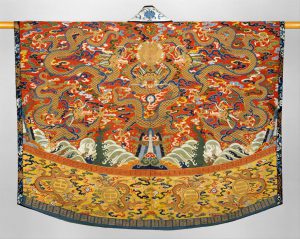
Silk and Metal thread
The Metropolitan Museum of Fine art; Gift of Florance Waterbury, 1943 ; 43.144
I of the underlying reasons for European expansion into the Americas was the pursuit of a west passage to Asia. China, specially, held a place of wonder in the minds of Europeans who began to imitate its signature goods in what became termed "Chinoiserie." Although for Europeans, the East was a trading partner providing goods such every bit spices, tea, and ceramic china, some of the goods that flowed out from the east were harder to come by and therefore less a commodity to be traded than an artifact or a curio that, inevitably, inspired European imitation.
Ane such item that inspired Chinoiserie were the silk robes worn by courtiers in the Ming dynasty court. In their original context they were a symbol that communicated a social status. The Jesuit priest Matteo Ricci, had to repeatedly petition his superior, Father Valignano, head of the Jesuit mission in Asia, for the ability to article of clothing such robes so as to gain access to the majestic Chinese court. The robe he wore was probable similar to the one pictured. Ricci picked the robes of a Daoist to communicate his office every bit a priest, albeit of an entirely different faith.
Although the French sericulture industry was created past Chinese silk piece of work that had made it to Europe prior to the late 16th century, it was the Jesuit missions of 1582 that began shipping Ming Court robes to Europe that reinforced the French practice of imitating Chinese textile. British travel writer, John Evelyn, came across Ming robes shipped by Jesuits as they stopped over in London on their way to Paris. In his diary from 1641-1697, he described robes having "splendor and vividness we have zippo in Europe that approaches it."
The french false cloth came to exist known as 'Damas de la Chine' and was ofttimes worn amongst French nobles to demonstrate wealth and status. An important moment frequently used by historians to demonstrate the importance of China on the Global phase in the early to mid 17th century is that of Jean Nicollet. He was supposed to have met with the native tribes of Wisconsin wielding pistols and wearing a Chinese robe. Historians recount this story to suggest that Nicollet likely thought he was to have set pes in Prc and was dressed to announced in Ming court.
This story likely arose due to a series of mistranslations. What Nicollet probably wore was non a 'robe' but a greatcoat of 'Damas de la Chine.' This fit his ambassadorial role equally the start French ambassador to make contact with this tribe. Nicollet was dressed in the formal attire of a French gentleman of his fourth dimension.
Ming robes nonetheless serve to demonstrate the currency that China had in European minds. Nicollet wore a cape made out of a French fake of a Chinese cloth equally he was in a pursuit of a westward passage to China achievable by ship. In a sense he doubly demonstrated the importance of People's republic of china to Europeans. Chinese exports similar the Ming robes inspired European industry in chinoiserie too every bit fueling the European desire to push westward through the new world.
Sources:
Beck, T. The Confusions of Pleasure: Commerce and Culture in Ming China . ACLS Humanities E-Book. University of California Press, 1999. https://books.google.com/books?id=YuMcHWWbXqMC.
Beck, Timothy. "Vermeer's Hat." In Vermeer's Lid , 49–51. New York: Bloomsbury Press, 2008.
Evelyn, John. "Diary of John Evelyn." In The Diary of John Evelyn , 1:372–74. Washington and London: Walter Dunne, n.d.
Fontana, Michela. Matteo Ricci : A Jesuit in the Ming Court . Lanham, Md: Rowman & Littlefield Publishers, 2011. https://login.avoserv2.library.fordham.edu/login?url=http://search.ebscohost.com/login.aspx?directly=true&db=nlebk&AN=361535&site=eds-live.
Jacobson, D. Chinoiserie . Phaidon Press, 1999. https://books.google.com/books?id=Km7FQgAACAAJ.
Jung, P.J. The Misunderstood Mission of Jean Nicolet: Uncovering the Story of the 1634 Journey . Wisconsin Historical Society Printing, 2018. https://books.google.com/books?id=ntpyDwAAQBAJ.
Patrick Jung, and Nancy Oestreich Lurie. "The Chinese Robe and Other Myths." Voyageur :Historical Review of Brown Canton and
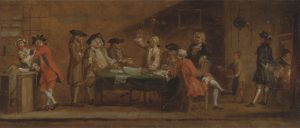
Oil on panel
Yale Eye for British Art, Paul Mellon Collection
Coffeehouses are intimately intertwined with the spirit of the Enlightenment. Coffeehouses like the 1 depicted here past Joseph Highmore were places of intellectual contend and helped facilitate the transmission of new ideas and modes of thought. The cardinal effigy in this painting is conspicuously in the midst of an impassioned debate. He and his peers wear dignified clothing while the boy on the right seems to exist serving them coffee.
Although the Enlightenment was a time of revolutionary thinking and new ideas concerning the inherent dignity of all human being beings, non all groups of people in Enlightenment-era Europe enjoyed immediate or lasting benefits every bit a outcome of these new modes of thought. European Jews constitute an case of one such grouping, and their plight can exist analyzed through the lens of the quintessential Enlightenment institution: the coffeehouse.
Yep, even in these dens of high-minded soapbox long-continuing biases against Jews prevented them from enjoying the full result of Enlightenment thinking. In that location are numerous reports of Jews beingness barred from entering Christian coffeehouses. This likewise extended to the java merchandise with the deprival of Jewish access to merchandise markets. Jews were promised increased economic freedoms in this era, merely these freedoms oft went unactualized.
This catamenia is understood to be a time of increased religious freedoms, simply information technology is fair to inquire the question: were the pb figures of the Enlightenment genuine in their support for tolerance? Voltaire might be the most prominent effigy of them all, but i need not await far to encounter that he was no fan of the Jewish people. He often spoke of his disdain for the Jews, nevertheless he was a staunch supporter of religious freedoms. Voltaire was far from the only Enlightenment effigy to hold these seemingly contrary views. Thus, this constitutes the fundamental paradox of the Enlightenment. Yes, the thinkers of the Age of Reason have greatly influenced political institutions and our modern conception of morality, but many of them held views about minority groups, particularly the Jews, that today we detect repulsive.
Coffeehouses provided a certain few with the power to discuss lofty ideas, but information technology is important to consider who is left out when viewing an Enlightenment-era painting such every bit this one. At the far left of the painting, one coffeehouse patron is grabbing the cervix of a visibly distressed woman while the others pay no heed and continue on with their discussion. Here Highmore unwittingly encapsulated the failures of the Enlightenment. In this era, rich white men discussed and wrote near important and worthwhile topics, only marginalized groups did not stand to benefit nearly as much equally those rich white men. In many cases, every bit is the instance with this painting, the men were the very ones who were subordinating these groups.
Sources:
"Figures in a Tavern or Java House – Joseph Highmore – Google Arts & Civilisation." Google Cultural Institute. Accessed December 10, 2018. https://artsandculture.google.com/asset/figures-in-a-tavern-or-coffee-firm/JQG0Ko6r2Seg6w.
Lausten, Martin Schwarz. "TOLERANCE AND ENLIGHTENMENT IN Kingdom of denmark: The Theologian Christian Bastholm (1740-1819) and His Attitude Toward Judaism." Nordisk Judaistik 19, no. ane–two (1998): 123–39.
Levy, Richard S., and Albert S. Lindemann. Antisemitism : A History. New York, NY: OUP Oxford, 2010. https://login.avoserv2.library.fordham.edu/login?url=http://search.ebscohost.com/login.aspx?direct=true&db=nlebk&AN=694173&site=eds-live.
Liberles, Robert. Jews Welcome Coffee : Tradition and Innovation in Early Modern Germany. The Tauber Plant Series for the Study of European Jewry. Waltham, Mass: Brandeis, 2012. https://login.avoserv2.library.fordham.edu/login?url=http://search.ebscohost.com/login.aspx?direct=true&db=nlebk&AN=447952&site=eds-live.
Voltaire, and Simon Harvey. Treatise on Tolerance. Cambridge Texts in the History of Philosophy. Cambridge ; New York : Cambridge University Press, 2000., 2000.
![[n.d.]. Citron x sour orange, Citrus medica L. x Citrus aurantium L.: whole and half-fruits. https://library.artstor.org/asset/ARTSTOR_103_41822003813548.](https://emh30.ace.fordham.edu/wp-content/uploads/2018/12/41822003813548-300x233.jpg)
Depicted is a watercolor painting of a citrus fruit, most likely a citron or sour orange, painted in the 17th century by the Italian artist, Cassiano Dal Pozzo. The image itself is nothing special, consisting of watercolors over blackness chalk and depicting a simple, anatomical diagram of a citrus fruit. Great detail is shown, with seed, pulp texture, coloration design, and irregularities all being paid careful attending. What is boggling about the drawing is not the image itself, but the socioeconomic and historical importance of its subject.
Citrus fruit was a crucial but often forgotten element of the transatlantic travel which made possible the discovery of the New World and the spread of colonialism. The events which occurred on account of citrus were an enormous step in the direction of modernity, eventually catalyzing major movements for social and political change such every bit the Enlightenment menstruum and the ascent of several bang-up empires. The reason for citrus' importance in oceanic travel is that it provided the nigh accessible and, at the time, most medically avant-garde cure for Scurvy, the disease which ravaged sea-faring crews in the 15th to 18th centuries, accounting for massive percentages of deaths at body of water.
Scurvy itself was a disease which arose from a lack of vitamin C in the nutrition, a discovery which Europeans did not make until much after when the research of James Lind confirmed what was already known: that oranges and lemons forestall and remedy scurvy. Even without the scientific reasoning for the method, the effects of citrus became widely known by the end of the 15th century among European explorers. Records from the voyages of Portuguese explorer, Vasco de Gama, indicate not merely an awareness of the disease, but a chaotic and ongoing struggle to cure it. This consisted of some ridiculous attempts such as the drinking of one'south ain urine and bloodletting. Other famous explorers such as Christopher Columbus also direct reference scurvy in their reports, some reporting decease rates greater than 80%.
When it was discovered that the cure for such a disparaging illness was so availably at mitt, the implementation of citrus in the diets of sailors was firsthand. Governments ensured the distribution of rations of oranges and lemons across naval crews in an effort to forbid the tragic and financially catastrophic loss of near entire crews. Earlier the expiry rate dropped and stabilized, governments of nations involved in the race for transatlantic exploration had get desperate enough to forcibly apply the residents of mental hospitals equally naval crews. The discovery of the fruit was a relief to all. It is important, however, to note that citrus fruit back then was not what it is today. Citrons and lemons were the main source of citrus, both of which were bitter and unpleasant to consume. Sweetness oranges were not introduced until later on when citrus fruits became genetically modified to taste better. Thus the citrus which sailors were made to eat was little better than a spoonful of medicine would be today.
Bibliography
[north.d.]. Citron x sour orange, Citrus medica L. x Citrus aurantium Fifty.: whole and half-fruits. https://library.artstor.org/nugget/ARTSTOR_103_41822003813548.
Mayberry, Jason A. "Scurvy and Vitamin C." Food and Drug Police, (2004): whole article.
Tiesler, Vera. "Scurvy‐related Morbidity and Death among Christopher Columbus' Crew at La Isabela, the First European Town in the New Earth (1494–1498): An Assessment of the Skeletal and Historical Information." (2014): whole commodity. https://docs.google.com/certificate/d/1LQkh6gRc3kL-PQhXGIu4skhDuBNS6VKQiS9X8iv1N0M/edit.
Earle, Rebecca. The Torso of The Conquistador., New York: Cambridge Academy Printing, 2012. Pg 54.
Lind, James. "A Treatise of the Scurvy, in 3 Parts." 1753. Accessed October 8, 2018. http://eds.a.ebscohost.com.avoserv2.library.fordham.edu/eds/item/detail?vid=3&sid=02d66b2-8b8c-4746-8130-8c77e1c6da1f@sessionmgr4009&bdata=JnNpdGU9ZWRzLWxpdmU=#AN=ford.1080465&db=cat00989a.
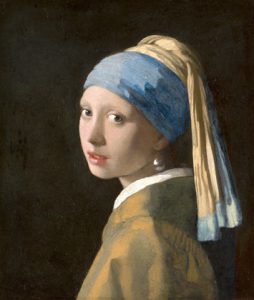
Oil on canvas.
Mauritshuis, inv. no. 670
I of the most captivating paintings of the Dutch Golden Age, Johannes Vermeer's Daughter with a Pearl Earringis a troniefeaturing a beautiful immature woman wearing foreign dress, a bluish and yellow turban, and an impossibly large pearl earring. As a tronie, the painting depicts an imaginary figure. She appears to exist either turning away from or facing the viewer, at once foreign and intimate. Her luminescent pearl earring lends the painting an otherworldly quality and signals the broader Dutch obsession with pearls in the 17th century.
Vermeer was a technical master of light and reflections. His other paintings depict figures in enclosed spaces with singular sources of light. He included multiple layers of oil paint to produce a luminous sfumatoeffect, a hazy contour. Girl with a Pearl Earringembodies Vermeer's artistic prowess. The massive pearl earring catches the low-cal and refracts information technology across the adult female's cute face. Her slightly parted lips comprise a sheen in the upper left corner, demonstrating how the pearl illuminates her sensuous face. The coaction of lite and darkness creates an intimate atmosphere betwixt the viewer and the painting's enigmatic effigy.
A famed painter of the Dutch Golden Age, Vermeer produced art at the peak of the Dutch maritime empire. The Dutch ended state of war with Spain in the 1648 Treaty of Münster, enabling the Dutch to operate freely in Eastern markets. Throughout the 17thcentury, the Dutch expanded merchandise through the Dutch East Republic of india Company (VOC) and gained a monopoly on the pearl trade in the East. Pearls became popular status symbols in holland, embodying the exotic beauty of the East. Just as the tulipmaniacraze saw Dutch elites paying exorbitant prices for tulips, the Dutch Gilded Age saw elite similarly pining for pearls. Pearls contained a strange mystique and were thus desirable objects. Vermeer often painted pearls in conjunction with women, drawing a parallel between the pearls' milky beauty with the ideal adult female'due south moral purity.
Daughter with a Pearl Earringis notable not only for its superb painting technique, only also for its reflection of European cocky-image. The adult female'due south turban, dress, and pearl earring are all symbols of foreignness to the European viewer, even so the woman'southward beautiful European face is familiar. The figure in Girl with a Pearl Earringembodies Europe— specifically the Dutch— on the precipice of a new, globalist age. Conflating European standards of beauty with Eastern "exoticism," the Europeans came to embrace foreign influences. Daughter with a Pearl Earring's tension betwixt Eastern and Western beauty is what captivates viewers.
Sources:
Atlas of World History. Edited by Patrick K. O'Brien. New York: Oxford Upward, 2002.
Brook, Timothy. Vermeer'southward Hat: The Seventeenth Century and the Dawn of the Global World.London: Bloomsbury Press, 2008.
Gifford, East. Melanie. "Painting Low-cal: Recent Observations on Vermeer's Technique." InVermeer Studies, edited by Ivan Gaskell and Michiel Jonker, 185- 199. Washington: National Gallery of Art, 1998.
Price, J.Fifty. Dutch Culture in the Golden Age. Reaction Books, 2011.
Sluiter, Engel. "Dutch Maritime Power and the Colonial Condition Quo, 1585- 1641." Pacific Historical Reviewxi, no. 1 (1942). Accessed Nov 29, 2018. http://penelope.uchicago.edu/Thayer/Due east/Journals/PacHR/11/1/Dutch_Maritime_power_and_the_Colonial_Status_Quo_1585_to_1641*.html.
Vermeer, Johannes.Girl with a Pearl Earring. 1665. Oil on canvas. Mauritshuis, the Hague. November, 13, 2018. https://www.mauritshuis.nl/en/discover/mauritshuis/masterpieces-from-the-mauritshuis/girl-with-a-pearl-earring-670/detailgegevens/.

Jan Swammerdam, Netherlands, 1669
Print, Book
Biodiversity Heritage Library; Cornell University Library
Swammerdam, January. Tertivs Ordo Nympha. 1669. Cornell Academy Library. In Historia Insectorum Generalis. Apud Jordanum Luchtmans, 1685. Plate 9. Accessed December iv, 2018. https://world wide web.biodiversitylibrary.org/item/132649#page/210/mode/1up
This plate, depicting the life wheel of ants, is the work of scientist and medical doctor January Swammerdam. Swammerdam trained as a medical doctor at the University of Leiden in 1661, and almost of his published works reference medical scientific discipline and especially the question of how breathing functions. This plate is from i of his rare forays into naturalist science publication, although it seems to have been his passion. His father pressured him into concentrating on medical science, hoping that January would earn a practical living, but his many friends encouraged him to follow his true interests and one of them even published his Biblia naturae after his death in 1680. The only works he published during his lifetime were a single monograph of a mayfly (which he proceeded to write a hymn to God nigh) and this text, the Historia Insectorum Generalis.
Swammerdam'south interest in ants was singular of the era, and for the most part they went unnoticed. While Swammerdam was stationed in the netherlands, his illustration of the ant life bicycle illuminates the reason these tiny, easily-killed individual organisms tin can and have get massive problems throughout history and in the contemporary globe. Ants, typically, take a reproductive cycle in which at that place are one or more "queens" who hold the sole ability to lay eggs. These eggs are all fertilized during a unmarried mating flying during a specific mating period commonly indicated past environmental conditions such as humidity, food availability, and—in some areas—whether the nest has been flooded recently. Ant-keepers often encourage increases in their colony size past introducing more food, which stimulates colony growth along with possible mating nymph production. After this mating flight, the queen lands, finds a suitable expanse to form a nest, and loses her wings. From this unmarried queen, every emmet in the colony will be laid and hatched.
This ability to substantially create a colony of several thousand (or more) ants is what makes ants such a potent environmental amanuensis, especially during a time such as the historic period of the Columbian Exchange when new stimuli were introduced to new countries. While people like Swammerdam showed rare involvement in insects and ants in particular, nigh individuals during the early modern menses failed to notice insects at all. One peculiarly stunning example of ants going unnoticed, despite massive indications of their role in a disaster, took identify in Hispaniola in 1518. The Spanish colonists in Hispaniola brought plantain trees from Africa to populate the plantations on the island and probably to assistance diversify the crops they could sell aside from sugar. Hiding away on these trees, still, was a plague that only became dangerous when introduced to the ecological system of Hispaniola: mealybugs.
When these mealybugs were introduced to Hispaniola, they were likewise introduced to an regular army of new friends: fire ants, or Solenopsis geminata. Due south. geminata is well-known to "herd" or "subcontract" mealybugs, even "milking" them for the sweet, calorie-rich waste product product they excrete called "honeydew". This new, massive availability of nutrient led to an explosion of pismire population, then much and then that colonists had to put the legs of their beds in bowls of water to prevent ants stinging them in their slumber as their floors were carpeted with thousands of ants. The plantations withered, but the colonists did not aspect this to the proper invaders; rather, they blamed the ants. The colonists had no intendance for the mechanisms of ants or how they actually functioned. That was unique to people like Jan Swammerdam, with passions that led u.s.a. to our current understanding of scientific discipline and specifically modern entomology.

porcelain, glaze, cobalt.
Rijksmuseum, Amsterdam, inv. no. AK-RBK-15808-B
The klapmuts soup bowl was named afterwards the broad-rimmed felt hats Dutch peasants traditionally wore during the Dutch Golden Historic period (c. 1600-1700). Artisans in the Chinese Ming and Qing dynasties produced klapmuts for Dutch markets. While the Chinese consumed their broth-like soup directly from the basin, the Dutch were forbidden to lift their bowls during meals. The klapmuts' shallow body and broad rim allowed European eaters to employ a spoon. The Chinese imbued their carefully-crafted porcelain exports with Chinese symbolism, leading the Dutch to consider klapmuts objects of good fortune. Klapmuts were prized in the Netherlands as signs of cosmopolitan wealth.
Chinese artisans aspiring afterwards shengong— divine worksmanship— produced klapmuts bowls. These frail blueish-and-white porcelain bowls had an ivory glaze and bore no trace of the potter'southward hand. When blueish-and-white pottery gained popularity in Europe, Chinese kilns became centers of unprecedented production. Chinese artisanship remained more than than mere product; it was a way to honor the dynasty through creative prowess. It was a significant source of dynastic pride to produce high-quality pottery on a big calibration.
The Dutch Eastward Republic of india Company (VOC) acquired klapmuts bowls through trade with China, marketing them in the Netherlands as "exotic" and "cheering." Chinese-produced klapmuts pervaded Dutch civilization as condition symbols, becoming staple pieces in still life paintings and aristocratic homes. The popularity of klapmuts bowls spurred Dutch reproductions of Chinese pottery. However, Delft-manner klapmuts were not of the same caliber every bit Chinses klapmuts.
This detail basin bears the "auspicious" prototype of a vase containing peacock feathers. Peacocks were the symbol of the Ming Dynasty, representing elegance and divine beauty. Peacock feathers served every bit status markers, as Chinese military machine and government officials wore peacock plumes in their hats. Members of the Chinese elite owned vases with small-scale gaps to showcase the feathers' fine quills. The "auspicious" image of peacock feathers was thus conflated with Chinese imperial power.
Furthermore, the image of a vase containing peacock feathers allowed artisans to demonstrate their superb technique. Klapmuts were fine pottery, and painting a vase with peacock feathers was an ambitious undertaking. The vase with peacock feathers enabled artisans to express their technical skills and honor their dynasty.
The klapmuts bowl is a remarkable emblem of an emerging global mindset in the early modern period. The Chinese tailored their products for a global market, accommodating Dutch cultural needs through the bowl's design. Simultaneously, the Chinese asserted their imperial might past including "auspicious" images of peacock feathers. The production and artisanship behind the klapmuts bowls demonstrate a marked awareness of Dutch-Chinese interdependence on the global stage.
Sources:
Basin (klapmuts) with flowering plants and auspicious objects. 1680-1720. Porcelain. Rijksmuseum, Amsterdam. October 12, 2018. https://world wide web.rijksmuseum.nl/en/search/objects?q=klapmuts&p=5&ps=12&st=Objects&ii=5#/AK-RBK-15808-B,53.
Brook, Timothy. Vermeer's Hat: The Seventeenth Century and the Dawn of the Global World.London: Bloomsbury Press, 2008.
Grub, Fong. "Symbolism in Chinese Porcelain: The Rockefeller Bequest." Metmuseum.org. https://www.metmuseum.org/pubs/bulletins/i/pdf/3258464.pdf.bannered.pdf(accessed October 12, 2009).
Hay, Jonathan. Sensuous Surfaces: The Decorative Object in Early Modern Prc. Honolulu: University of Hawai`i Press, 2010.
Welch, Patricia Bjaaland. Chinese Art: A Guide to Motifs and Visual Imagery. Singapore: Tuttle Publishing, 2008.
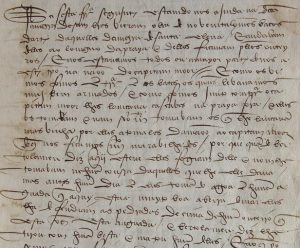
African interest in the Spice Trade was minimal before Vasco da Gama'due south journey around the Cape of Good Hope. At this fourth dimension, trade between Europe and Asia was flourishing, and European countries were becoming more and more dependent on Asian production equally need for spices increased. However, some spices of particular value to Europe, such equally cloves, were simultaneously being developed in Africa and had yet to be exported into the larger spice trade. Vasco da Gama'southward exploration throughout the Swahili coast brought to the Portuguese a new sense of appreciation for African potential in the spice trade. Through this, Portugal'due south ultimately gained command of African spice exports, bringing countries like Zanzibar an opportunity to develop their manufacture of cloves on a larger scale. This resulted in Zanzibar's part as a leading clove exporter by the nineteenth century.
The Spice Trade was a colonnade of early modern globalism, broadening European economies to an intercontinental scale and connecting European and Asian cultures through food. A range of spices poured into Europe from Cathay, Indonesia, and Republic of india that introduced flavor into the European diet and novelty into their medicine. Nutmeg, pepper, ginger, cloves, and more were " believed to cure disorders of the stomach, the intestines, the head, and the chest, and were also used to aid digestion." Spices were also used in diverse ways through cooking, helping to preserve meat, mask undesirable odors, and add flavor to food. These multifaceted spices were of not bad value to populations throughout the European continent, and travelers went to great lengths to bring them to the market. Prior to Vasco da Gama's voyage in the Indian Ocean, the Spice Road centered around a number of unlike cities throughout Asia. However, in 1498, when Vasco da Gama rounded the Cape of Good Hope and arrived in Calicut, he prompted a new age of Euro-Asian trade for Portugal, besides every bit introducing a larger role for African countries in the spice trade.
Da Gama introduced new trade partners for Portugal in various African countries along the Swahili coast, including Zanzibar. This expedition established the Cape Route through the Indian Ocean, a new lifeline to African and Indian spices in which Portugal "promptly exercised the right to its sectional employ." Vasco da Gama's 1498 voyage reveals much about the spice merchandise, and the Portuguese heart for economic potential in Africa. While stopping in modern-twenty-four hour period Kenya, da Gama encountered merchants from India in search of their own spices. This city was full with "quantities of cloves, cumin, ginger, nutmeg, and pepper," suggesting that the spice trade was well underway in Africa by the time da Gama arrived, despite its focus in Europe and Asia. Ultimately, Portuguese interest in Africa brought African spice evolution to considerable prominence in the Spice Merchandise throughout the early modern era.
Sources:
Da Gama, Vasco. "Journal of the First Voyage of Vasco Da Gama to Bharat, 1497−1499."World Digital Library, www.wdl.org/en/detail/10068/.
A Periodical of the First Voyage of Vasco Da Gama, 1497–1499, Cambridge University Printing, Cambridge, 2010, pp. 48. Cambridge Library Collection – Hakluyt Outset Serial.
Prakash, Om. "Spices and Spice Trade."The Oxford Encyclopedia of Economic History, Oxford University Press, 2005.
Source: https://emh30.ace.fordham.edu/category/trade/
Post a Comment for "Cape of Good Hope Clipart Ming Dynasty Clip Art"